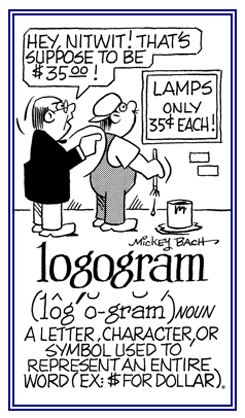gram-, -gram-, -gram, -grammatic, -grammatical, -grammatically, -gramme, -grammic +
(Greek: write, writing, something written, a written record, a recording; letters; words; later, a small weight, a unit of mass in the metric system)
A unit of weight in the metric system from 1797 gramme, borrowing of French gramme, from Late Latin gramma, "small weight"; from Greek gramma, "small weight"; originally, "something written"; from the stem of graphein, "to draw, to write".
2. A written work composed of words chosen so as to avoid the use of one or more specific alphabetic characters.
3. A composition from which the writer rejects all words that contain a certain letter or letters.
Writing a lipogram is a trivial task for uncommon letters like "z", "j", or "x"; but it is much more difficult for common letters like "e". Writing this way is impractical, as the author must omit many ordinary words, resulting in stilted-sounding text that can be difficult to understand. Well-written lipograms are rare.
An example of a lipogrammatic writing is the classical Odyssey of Tryphiodorus in which there was no "a" in the first book, no "b" in the second book, and so on.
Another example of a lipogram is the following sentence which is considered to be something of an achievement; since the letter "t" is the second most commonly used letter in English: "Brisk pigmy gnome hides pudgy black while brash demon group, grown plump hawky, wreck cabin, would lynch dusky scamp."
Still another example of a lipogram is the following: "Profs from Oxford show frosh who do post-docs how to gloss works of Wordsworth." This sentence does not use any of the letters: "a", "e", "i", and "u".
2. A written work that is composed of words chosen so as to avoid the use of one or more specific alphabetical characters.
An example of lipogrammatism: "It is an odd kink of humanity which cannot find any valuation in spots of natural glory." This sentence omits the letter "e".
Some logograms are found on road signs, in advertising, etc., and all are designed to represent in simple graphic form an object, a concept, or an attitude.

Go to this Word A Day Revisited Index
so you can see more Mickey Bach illustrations.
2. Descriptive of a letter, a symbol, or a sign used to represent an entire word; for example, & (ampersand), % (percent), @ (at), and $ (dollar) are logogrammatic symbols.
Related "writing" word units:
glypto-;
graph-;
scrib-, script-.


